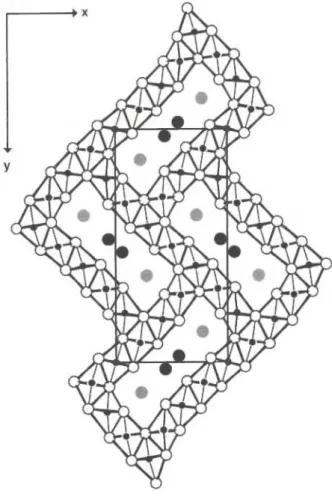Ζ. Kristallogr. NCS 215 (2000) 9 - 1 0
© by Oldenbourg Wissenschaftsverlag, München
9
Crystal structure of trirubidium dodekaselenoheptadysprosate(III), Rb 3 Dy 7 Sei2
M. Folchnandt and Th. Schleid*
Universität Stuttgart, Institut für Anorganische Chemie, Pfaffenwaldring 55, D-70569 Stuttgart, Germany
Dedicated to Professor Gerd Meyer (Universität Köln) on the occasion of his 50th birthday
Received October 18, 1999, CSD-No. 409446Abstract
Dy
7Rb3Sei2, orthorhombic, Pnnm (No. 58), a = 12.590(1) Ä, b = 26.183(2) Ä, с = 4.1271(4) Ä, V= 1360.5 Ä
3, Z = 2, Rgt(F) = 0.054, wR(F
2) = 0.119, Τ = 293 К.
Source of material
S t r a w - y e l l o w , l a t h - s h a p e d , t r a n s p a r e n t s i n g l e c r y s t a l s of Rb3Üy7Sei2 were obtained from the elements dysprosium and se- lenium (about 1:2 molar ratios) in the presence of large amounts of RbCl as fluxing agent upon heating the mixture in a sealed evacuated silica vessel at 1123 К for seven days followed by sub- sequent cooling down to ambient temperature.
Discussion
The crystal structure of Rb3Dy7Sei2 belongs to the Cs3Y7Sei2- type arrangement [1,2], as is the case for some ternary tricesium heptalanthanoid dodekaselenides, Cs3M7Sei2 (M = Gd-Ho, [3-5]), and Rb3Yb7Sei2 [6]. The orthorhombic unit cell contains [DySe6]
9octahedra which share common vertices and edges to f o r m a t h r e e - d i m e n s i o n a l a n i o n i c n e t w o r k a c c o r d i n g to j{(Dy
7Sei2)
3 -}. The Dy—Se distances range from 280 pm to 298 pm with an average of 286.6 pm. This rigid frame exhibits one-dimensional channels along [001] apt to take up three Rb
+cations per formula unit offering coordination numbers of six (trigonal prism for Rb2) and seven plus one (bicapped trigonal prism for Rb 1). Since both sites for rubidium are fourfold (4g, see table 2) one of them, the Rb2 site namely, has to be half-occupied only with a refined occupation probability of 0.52(1). The Rb—Se distances are found in intervals between 347 pm and 371 pm (plus 447 pm) for Rb 1 or between 340 pm and 391 pm for Rb2, respectively. A (001) projection of the crystal structure of Rb3Dy7Sei2 is given in the figure (Rb: large black and grey, Dy: small black, Se: large open circles) where the condensed [DySee]
9octahedra are depicted by linked Se—Se edges.
Table 1. Data collection and handling.
Crystal: straw-yellow, transparent, lath-shaped needle, size 0.05 χ 0.08 χ 0.25 mm Wavelength: Mo Ka radiation (0.71069 Ä)
μ: 403.42 cm"'
Diffractometer, scan mode: Stoe IPDS, 200 exposures, Δφ = 1 °
20max: 48.16°
N(hkl)measured, N(hkl)u„jque: 6259, 1241 Criterion for l0bs, N(hkl)gC. /„bs > 4 of/obs), 1092 N(param) refi„ed: 72
Programs: HABITUS [7], SHELXS-86 [8],
SHELXL-93 [9]
* Correspondence author (e-mail:schleid@iac.uni-stuttgart.de )
10
Trirubidium dodekaselenoheptadysprosate(III)T a b l e 2. Atomic coordinates and displacement parameters (in Ä2).
Atom Site Occ. X У ζ Uu U22 t/33 Un Un I/23
Rb(l) 4« 0.2879(2) 0.3661(1) 0 0.023(2) 0.037(2) 0.025(2) 0.004(1) 0 0
Rb(2) 4g 0.52(1) 0.5612(5) 0.0297(3) 0 0.031(4) 0.038(5) 0.078(6) 0.013(3) 0 0
Dy(l) 2 a 0 0 1/2 0.0149(9) 0.0133(9) 0.0092(9) -0.0027(8) 0 0
Dy(2) 0.2174(1) 0.08384(5) 0 0.0148(7) 0.0158(7) 0.0086(6) -0.0038(5) 0 0
Dy(3) 4« 0.4091(1) 0.71186(5) 0 0.0134(7) 0.0148(7) 0.0090(6) -0.0015(5) 0 0
Dy(4) 4g 0.0775(1) 0.68252(5) 0 0.0138(7) 0.0160(7) 0.0101(7) 0.0035(5) 0 0
Se(l) 4g 0.2540(2) 0.1962(1) 0 0.011(1) 0.017(1) 0.008(1) -0.001(1) 0 0
Se(2) 4g 0.1289(2) 0.5776(1) 0 0.015(1) 0.018(1) 0.013(1) 0.003(1) 0 0
Se(3) 4S 0.4336(2) 0.6035(1) 0 0.012(1) 0.015(1) 0.010(1) 0.000(1) 0 0
Se(4) 4 5 0.0593(2) 0.7891(1) 0 0.008(1) 0.013(1) 0.011(1) -0.003(1) 0 0
Se(5) 4 g 0.1531(2) 0.9805(1) 0 0.014(1) 0.016(1) 0.011(1) 0.001(1) 0 0
Se(6) 4 g 0.4235(2) 0.8212(1) 0 0.015(1) 0.016(1) 0.011(1) -0.000(1) 0 0
References
1. Folchnandt, M.; Schleid, Th.: Cs3Y7Sei2: A New Ternary Compound in the Cs2Se-Y2Se3 System. Z. Kristallogr. Suppl. 11 (1996) 80.
2. Folchnandt, M.; Schleid, Th.: Synthese und Kristallstruktur von Cs3Y7Sei2. Ζ. Anorg. Allg. Chem. 623 (1997) 1501 -1502.
3. Folchnandt, M.; Schleid, Th.: Neue ternäre Selenide dreiwertiger Lanthanoide mit Cäsium: CsNdsSee, Cs3Gd7Sei2 und CsEoSes. Z.
Kristallogr. Suppl. 12 (1997) 125.
4. Folchnandt, M.; Schleid, Th.: Ternäre Selenide der Lanthanide mit Alkalimetallen: I. Der Formeltyp Cs3M?Sei2 (M = Gd-Ho). Z. Anorg.
Allg. Chem. 624 (1998) 1595-1600.
5. Folchnandt, M.: Ternäre Selenide und Telluride der Selten-Erd-Metalle.
Dissertation, University of Stuttgart, Germany 1997.
6. Kim, S.-J.; Park, S.-J.; Yun, H.; Do, J.: Syntheses and Crystal Structures of New Ternary Selenides: Rb3Yb7.Se 11 and CsHnSes. Inorg. Chem. 35 (1996) 5283-5289.
7. Herrendorf, W.; Bärnighausen, H.: HABITUS, Programm zur Opti- mierung der Kristallgestalt für die Absorptionskorrektur. University of Karlsruhe, Germany 1993, 1996.
8. Sheldrick, G. M.: Phase Annealing in SHELX-90: Direct Methods for Larger Structures. Acta Crystallogr. A46 (1990) 467-473.
9. Sheldrick, G. M.: SHELXL-93. Program for the Refinement of Crystal Structures. University of Göttingen, Germany 1993.
